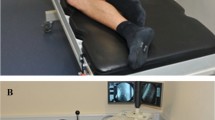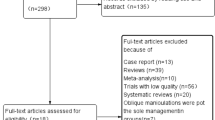Abstract
Purpose
Our aim was to study the influence of segmental variations in intervertebral disc degeneration on the location of acute osteoporotic compression fractures and to investigate chronic effect of such fractures on adjacent discs.
Methods
This retrospective study included 83 patients (69 females; mean ± SD age: 72.3 ± 14.0 years) with osteoporotic vertebral fractures. Using lumbar MRI, two neuroradiologists evaluated 498 lumbar vertebral segments for the presence and acuity of fractures and graded adjacent intervertebral disc degeneration on Pfirrmann’s scale. Absolute and relative (to average patient-specific degeneration grade) segmental degeneration grades were compared against the presence and chronicity of vertebral fractures for all segments and for upper (T12-L2) and lower (L3-L5) subgroups. Intergroup analysis was conducted using Mann–Whitney U tests, with p value of < .05 considered significant.
Results
Fractures involved 149/498 (29.9%; 15.1% acute) vertebral segments, majority (61.1%) involving T12-L2 segments. Segments with acute fractures had significantly lower degeneration grades (mean ± SD: absolute: 2.72 ± 0.62; relative: 0.91 ± 0.17) than those with no (absolute: 3.03 ± 0.79, p = 0.003; relative: 0.99 ± 0.16, p < 0.001) or chronic fractures (absolute: 3.03 ± 0.62, p = 0.003; relative: 1.02 ± 0.16, p < 0.001). Degeneration grades were higher in the lower lumbar spine (p < 0.001) in the absence of fractures, but comparable to upper spine for segments with acute or chronic fractures (p = 0.28 and 0.56, respectively).
Conclusions
Osteoporotic vertebral fractures favour segments with lower burden of disc degeneration, but likely contribute to subsequent worsening of adjacent disc degeneration.



Similar content being viewed by others
References
Ensrud KE, Schousboe JT (2011) Clinical practice. Vertebral fractures N Engl J Med 364(17):1634–1642. https://doi.org/10.1056/NEJMcp1009697
Adams MA, McNally DS, Dolan P (1996) 'Stress' distributions inside intervertebral discs. The effects of age and degeneration. J Bone Joint Surg Br 78(6):965–972. https://doi.org/10.1302/0301-620x78b6.1287
Dai L (1998) The relationship between vertebral body deformity and disc degeneration in lumbar spine of the senile. Eur Spine J 7(1):40–44. https://doi.org/10.1007/s005860050025
Miyakoshi N, Itoi E, Murai H, Wakabayashi I, Ito H, Minato T (2003) Inverse relation between osteoporosis and spondylosis in postmenopausal women as evaluated by bone mineral density and semiquantitative scoring of spinal degeneration. Spine 28(5):492–495. https://doi.org/10.1097/01.BRS.0000048650.39042.58
Sornay-Rendu E, Munoz F, Duboeuf F, Delmas PD (2004) Disc space narrowing is associated with an increased vertebral fracture risk in postmenopausal women: the OFELY Study. J Bone Miner Res 19(12):1994–1999. https://doi.org/10.1359/JBMR.040904
Sornay-Rendu E, Allard C, Munoz F, Duboeuf F, Delmas PD (2006) Disc space narrowing as a new risk factor for vertebral fracture: the OFELY study. Arthritis Rheum 54(4):1262–1269. https://doi.org/10.1002/art.21737
Roux C, Fechtenbaum J, Briot K, Cropet C, Liu-Léage S, Marcelli C (2008) Inverse relationship between vertebral fractures and spine osteoarthritis in postmenopausal women with osteoporosis. Ann Rheum Dis 67(2):224–228. https://doi.org/10.1136/ard.2007.069369
Pariente E, Olmos JM, Landeras R, Nan D, González-Macías J, Hernández JL (2017) Relationship between spinal osteoarthritis and vertebral fractures in men older than 50 years: data from the Camargo Cohort Study. J Bone Miner Metab 35(1):114–121. https://doi.org/10.1007/s00774-016-0735-1
Takegami N, Akeda K, Murata K, Yamada J, Sudo A (2020) Association between non-traumatic vertebral fractures and adjacent discs degeneration: a cross-sectional study and literature review. BMC Musculoskelet Disord 21(1):781. https://doi.org/10.1186/s12891-020-03814-0
Pfirrmann CW, Metzdorf A, Zanetti M, Hodler J, Boos N (2001) Magnetic resonance classification of lumbar intervertebral disc degeneration. Spine 26(17):1873–1878. https://doi.org/10.1097/00007632-200109010-00011
Harada A, Okuizumi H, Miyagi N, Genda E (1998) Correlation between bone mineral density and intervertebral disc degeneration. Spine 23(8):857–861. https://doi.org/10.1097/00007632-199804150-00003
Pye SR, Reid DM, Adams JE, Silman AJ, O’Neill TW (2006) Radiographic features of lumbar disc degeneration and bone mineral density in men and women. Ann Rheum Dis 65(2):234–238. https://doi.org/10.1136/ard.2005.038224
Wang Y, Boyd SK, Battié MC, Yasui Y, Videman T (2011) Is greater lumbar vertebral BMD associated with more disc degeneration? A study using µCT and discography. J Bone Miner Res 26(11):2785–2791. https://doi.org/10.1002/jbmr.476
Polikeit A, Nolte LP, Ferguson SJ (2004) Simulated influence of osteoporosis and disc degeneration on the load transfer in a lumbar functional spinal unit. J Biomech 37(7):1061–1069. https://doi.org/10.1016/j.jbiomech.2003.11.018
Wang J, Zhou Y, Zhang ZF, Li CQ, Zheng WJ, Liu J (2013) Radiological study on disc degeneration of thoracolumbar burst fractures treated by percutaneous pedicle screw fixation. Eur Spine 22(3):489–494. https://doi.org/10.1007/s00586-012-2462-1
Sander AL, Lehnert T, Saman AE, Eichler K, Marzi I, Laurer H (2014) Outcome of traumatic intervertebral disc lesions after stabilization by internal fixator. Am J of Roentgenol 203(1):140–145. https://doi.org/10.2214/AJR.13.11590
Noriega DC, Marcia S, Ardura F, Lite IS, Marras M, Saba L (2016) Diffusion-weighted MRI assessment of adjacent disc degeneration after thoracolumbar vertebral fractures. Cardiovasc Intervent Radiol 39(9):1306–1314. https://doi.org/10.1007/s00270-016-1369-3
Sharma A, Pilgram T, Wippold FJ (2009) Association between annular tears and disc degeneration: a longitudinal study. AJNR Am J Neuroradiol 30(3):500–506. https://doi.org/10.3174/ajnr.A1411
Sharma A, Parsons M, Pilgram T (2011) Temporal interactions of degenerative changes in individual components of the lumbar intervertebral discs: a sequential magnetic resonance imaging study in patients less than 40 years of age. Spine 36(21):1794–1800. https://doi.org/10.1097/BRS.0b013e31821590ad
Oh CH, Yoon SH (2017) Whole spine disc degeneration survey according to the ages and sex using Pfirrmann disc degeneration grades. Korean J Spine 14(4):148. https://doi.org/10.14245/kjs.2017.14.4.148
Funding
No funds, grants, or other support were received.
Author information
Authors and Affiliations
Corresponding author
Ethics declarations
Conflict of interest
The authors have no relevant financial or non-financial interests to disclose.
Ethical standards
The study was granted exemption by the University of Michigan Medical School Institutional Review Board and was performed in accordance with the ethical standards as laid down in the 1964 Declaration of Helsinki and its later amendments or comparable ethical standards.
Additional information
Publisher's Note
Springer Nature remains neutral with regard to jurisdictional claims in published maps and institutional affiliations.
Rights and permissions
Springer Nature or its licensor (e.g. a society or other partner) holds exclusive rights to this article under a publishing agreement with the author(s) or other rightsholder(s); author self-archiving of the accepted manuscript version of this article is solely governed by the terms of such publishing agreement and applicable law.
About this article
Cite this article
Sharma, A., Martin, P.R. & Rodriguez, F.R. Lumbar osteoporotic fractures develop in segments with less degenerated discs which then become more degenerated. Eur Spine J 32, 1437–1445 (2023). https://doi.org/10.1007/s00586-023-07573-z
Received:
Revised:
Accepted:
Published:
Issue Date:
DOI: https://doi.org/10.1007/s00586-023-07573-z




